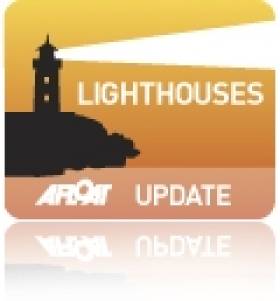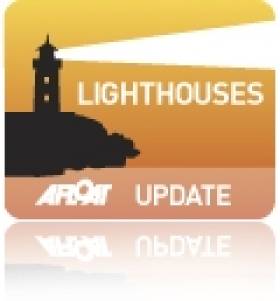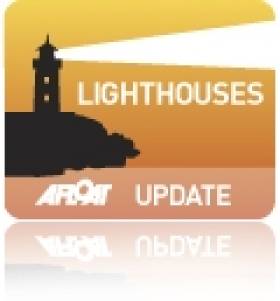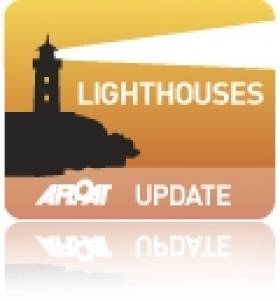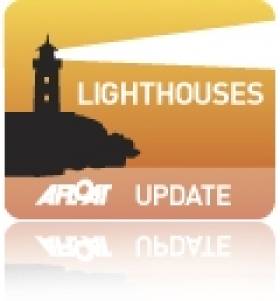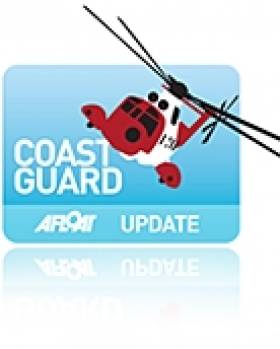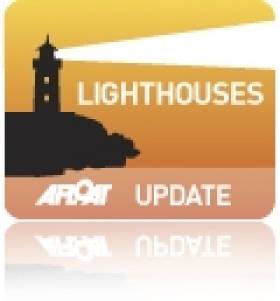Displaying items by tag: Loop Head
Record Visitor Numbers at Loop Head Lighthouse
#loopheadlight – Visitors to Loop Head Lighthouse increased by 7.5% during the West Clare landmark's 6-month opening period up to yesterday (Sunday, October 5th).
Figures released today by Clare County Council, which manages the facility in conjunction with the Commissioners of Irish Lights (CIL), reveal that a record 20,368 people visited the 19th century lighthouse.
61% of the total visitor figure was represented by Irish visitors, with North America, the United Kingdom (UK) and Germany each accounting for 8% of the overall figure. Italian and French visitors meanwhile, represented just over 5% of the total figure.
Gerard Dollard, Director of Services, Tourism & Community, Clare County Council said visitor numbers at the lighthouse were buoyed by the development of new services at Shannon Airport, favourable weather conditions during September, and the launch of the Wild Atlantic Way.
"Loop Head Lighthouse is now finishing its fourth year of operation as a visitor attraction. During this time, it has become firmly established as one of Clare's most popular visitor attractions," he said.
Mr. Dollard continued: "Visitor numbers in 2014 have been very much helped by the launch of additional services to and from Shannon Airport and the strong start-up promotion of the Wild Atlantic Way. Of particular notice has been the very strong visitor numbers during the month of September which was no doubt helped by the very fine weather but also by large numbers of American visitors."
"In 2014, the Council provided additional toilet facilities at the site and upgraded and improved the car park area. We will now review the season and examine what further improvements and additional visitor experience can be put in place for 2015," he concluded.
Loop Head Lighthouse, located at the mouth of the Shannon Estuary, is steeped in history and rich in maritime heritage with its origins dating back to the 1670s. The existing tower style lighthouse was constructed in 1854 and was operated and maintained by a keeper who lived within the lighthouse compound.
Taoiseach Enda Kenny's grandfather was a keeper at the lighthouse. James John McGinley took up duty at the Lighthouse as Principal Keeper on 16th January 1933. He spent 1 year and 10 months at Loop Head. He was transferred from the station in October 1934. In January 1991, the lighthouse was converted to automatic operation, and today is in the care of an attendant and is also monitored by the CIL. The Lighthouse is today one of the key discovery points along the route of the Wild Atlantic Way.
Ham Radio Users Light Up the Airwaves at Loop Head
#loophead – A group of amateur ham radio operators will wind back the clock at Loop Head Lighthouse this weekend when they attempt to communicate via radio and Morse code with hundreds of radio clubs throughout the world.
The Limerick Radio Club, which features members from Clare, Kerry, Limerick and Tipperary, will broadcast non-stop for 48 hours from the West Clare lighthouse as part of the 17th International Lighthouse & Lightship Weekend (ILLW).
During the broadcast from midnight on Friday to midnight on Sunday, visitors to the popular tourism landmark will be able to listen into communications with some of the other participating ham radio operators broadcasting from 400 other lighthouses and lightships in 65 countries.
Last year, the Limerick Radio Club successfully made contact with lighthouses and lightships as far away as Brazil, Australia, Tonga, French Guiana, Asiatic Russia, Ecuador, The Azores and The US Virgin Islands. The majority of all radio contacts were made with operators in the United States (200), Germany (155) and Italy (76). 61% of overall communication was conducted via radio with the remaining 39% being conducted via Morse code.
The group also attempted to communicate with its twinned club in South Jersey using Earth-Moon-Earth communication, also known as "moon bounce". First developed by the US Military after World War Two, the radio communications technique involves radio waves travelling from one transmitter to another using the Moon as a reflector.
Clare County Council, along and the Commissioners of Irish Lights (CIL), is facilitating the broadcast from Loop Head Lighthouse while the Limerick Radio Club has also received approval from Ireland's Communications Regulator, Comreg.
"Thanks to Clare County Council and the CIL we will once again be basing ourselves on the edge of the Loop Head Peninsula at the lighthouse in an effort to open long distance communications with regions in Asia, North and South America, Australia, New Zealand and throughout Europe," explained Simon Kenny of the Limerick Radio Club:
Mr. Kenny said Loop Head Lighthouse is particularly suitable for long distance radio and Morse code communications attempts due to its isolated location on the edge of the Atlantic Ocean and the lack of radio interference in the general area
He added: "A special QSL Card (confirmation of communication) has been designed to mark the event. The club will operate two stations, one of which will be at the entrance to the Lighthouse so members of the public can listen to some of the transmissions."
Loop Head Lighthouse, located at the mouth of the Shannon Estuary, is steeped in history and rich in maritime heritage with its origins dating back to the 1670s. The existing tower style lighthouse was constructed in 1854 and was operated and maintained by a keeper who lived within the lighthouse compound. In January 1991, the lighthouse was converted to automatic operation, and today is in the care of an attendant and is also monitored by the CIL.
The 19th century lighthouse was opened for a fourth successive season in late April and will remain open to the public each day from 10am until 6.00pm until the end of September. More than 8,000 people, 43% of whom came from abroad, visited the lighthouse during May, June and July.
"We are delighted to be able to facilitate members of the Limerick Radio Club, who have helped to further raise the profile of Loop Head Lighthouse through their conversations over the airwaves with fellow ham radio operators internationally," commented Gerard Dollard, Director of Services, Clare County Council.
He added: "The International Lighthouse & Lightship Weekend is a wonderful mechanism for connecting and promoting the shared maritime heritage of countries throughout the world. We wish the members of Limerick Radio Club the very best of luck over the coming weekend."
Further information on the annual International Lighthouse & Lightship Weekend (ILLW) is available from www.limerickradioclub.ie and www.illw.net. Visit www.loophead.ie or www.clare.ie for more information on Loop Head Lighthouse and the Loop Head Peninsula.
Loop Head Lighthouse Visitor Numbers Up
#loophead – One of Clare's newest and most popular tourism attractions, Loop Head Lighthouse has recorded an increase in visitor numbers this summer compared to 2013.
New figures show that the expansion of services at Shannon Airport and the designation of the West Clare tourism landmark as one of the discovery points along the route of the Wild Atlantic Way is having a positive impact on visitor numbers.
Figures released today by Clare County Council, which manages the facility in conjunction with the Commissioners of Irish Lights (CIL), reveal that 7,732 people have visited the 19th century lighthouse since it was opened for the summer period in late April, representing a 4% increase on the same period in 2013.
The local authority says 57% of the total visitor figure was represented by domestic visitors, with North America, Germany and the United Kingdom accounting for 10%, 9% and 6% of the overall figure respectively. Italian and French visitors meanwhile, represent just over 5% of the total figure.
Martin Gleeson, Supervisor at Loop Head Lighthouse commented: "This is fantastic news for the Lighthouse and the wider Loop Head Peninsula when you consider we are only now entering the peak tourism season. The launch of the Wild Atlantic Way, the development of new services at Shannon Airport, and the upgrading of visitor facilities at the lighthouse have been significant contributory factors to the growth in visitors. There is a noticeable increase in visitors from Germany and North America with the French and Italian markets also appearing particularly strong."
"The success of the Loop Head Lighthouse visitor project is indicative of the wider Peninsula's increasing popularity as a sustainable, visitor destination," added Kathy Lordan, Tourism & Community, Clare County Council.
Ms. Lordan continued: "The Council maintains a positive working relationship with local communities and indeed, Loop Head Tourism in developing, managing and showcasing the wonderful tourism assets on offer at the Peninsula from Loophead Lighthouse to the Bridges of Ross to Kilkee Bay. I am sure the marketing of the Peninsula and continued investment in the local tourism infrastructure that numbers visiting the area will show further increases during the remainder of the summer season and in future years."
Loop Head Lighthouse, located at the mouth of the Shannon Estuary, is steeped in history and rich in maritime heritage with its origins dating back to the 1670s. The existing tower style lighthouse was constructed in 1854 and was operated and maintained by a keeper who lived within the lighthouse compound.
Taoiseach Enda Kenny's grandfather was a keeper at the lighthouse. James John McGinley took up duty at the Lighthouse as Principal Keeper on 16th January 1933. He spent 1 year and 10 months at Loop Head. He was transferred from the station in October 1934. In January 1991, the lighthouse was converted to automatic operation, and today is in the care of an attendant and is also monitored by the CIL.
Loop Head Lighthouse will remain open daily (10am-6pm) until the end of September. Admission, which includes the exhibition and guided tour of the site, is Adults (€5), Children (€2) and Family Passes for up to 2 adults + 3 children (€12). Visit www.loophead.ie or www.clare.ie for more information on Loop Head Lighthouse and the Loop Head Peninsula.
Popular Loop Head Lighthouse Opens this Easter Weekend
The Loop Head Lighthouse in West Clare will reopen to the public this Saturday (April 19th 2014), Clare County Council has announced.
The Local Authority, which manages the facility in conjunction with the Commissioners of Irish Lights (CIL), says the historic lighthouse will remain open daily (10am-6pm) until the end of September.
The popular tourist attraction, which is one of two "Signature Discovery Points" in County Clare along the route of the recently launched Wild Atlantic Way, attracted 19,000 visitors during the six-month opening period in 2013. The figure represents an increase of 2,000 on the same period in 2012.
According to Mayor of Clare Cllr. Joe Arkins: "Loop Head Lighthouse has proven to be one of the tourism success stories for County Clare in recent years and has helped to strengthen the profile, both nationally and internationally, of the wider Loop Head Peninsula and what it has to offer as a tourism destination."
"I want to pay tribute to Clare County Council for its ongoing work to develop the lighthouse, particularly through the provision of a new interpretative space and exhibition which has added greatly to the overall visitor experience. I warmly welcome any efforts made to help County Clare maintain and grow a competitive advantage in tourism terms," he added.
Siobhan Garvey, Marketing and Development Officer for West Clare stated: "The public opening of Loop Head Lighthouse will provide a significant boost to the local tourism sector and the economy, which has benefited greatly since the attraction was first opened to the public in 2012. The fact that the attraction is opening on a 7-days-a-week basis from this Easter Bank Holiday Weekend is particularly timely as the Lighthouse is one of two local Discovery Points along the Wild Atlantic Way."
Loop Head Lighthouse, located at the mouth of the Shannon Estuary, is steeped in history and rich in maritime heritage with its origins dating back to the 1670s. The existing tower style lighthouse was constructed in 1854 and was operated and maintained by a keeper who lived within the lighthouse compound. In January 1991, the lighthouse was converted to automatic operation, and today is in the care of an attendant and is also monitored by the CIL.
Admission to Loop Head Lighthouse, which includes the exhibition and guided tour of the site, is Adults (€5), Children (€2) and Family Passes for up to 2 adults + 3 children (€12). Visit www.loophead.ie or www.clare.ie for more information on Loop Head Lighthouse and the Loop Head Peninsula.
Loop Head Tourism Infrastructure Projects Completed
Clare County Council has completed two important tourism infrastructure projects in West Clare.
The projects at the Bridges of Ross and the West End Car Park in Kilkee cost €110,000 and €150,000 to complete respectively, and were both funded by Clare County Council and the Department of Agriculture, Food and the Marine.
The Bridges of Ross, a well known tourist location on the Loop Head Peninsula, has benefited from an upgrade to the local carpark and the surfacing of approximately 450 metres of access way. The works were carried out by Council staff supported by Oliver Keating Contractors and are aimed specifically at boosting marine tourism in the local area, which is renowned for its coastal geological features and marine life as well as being one of Ireland's best birdwatching locations.
Meanwhile, Council staff have completed a €150,000 resurfacing project at the West End car park in Kilkee providing additional car parking capacity for the popular tourist town.
"I very much welcome the completion of these small but very important schemes at two of Clare's most popular tourist locations," stated Mayor of Clare Cllr Joe Arkins.
He continued: "Both the Bridges of Ross and Kilkee, together with Loop Head and Carrigaholt feature strongly on the Wild Atlantic Way which is to be launched during 2014 and I have no doubt that visitors coming to these locations will appreciate the improved facilities that are now in place. The investments made on both of these projects reflect the Council's commitment to tourism and to continually building the tourism product in the rural parts of County Clare.
Siobhan Garvey, Marketing and Tourism Officer for West Clare said the improvement works complement the raised profile of the Loop Head Peninsula as a quality, accessible and sustainable visitor destination.
"The Loop Head Peninsula has become a very popular destination, as exemplified earlier this year when it won The Irish Times Best Place to Holiday in Ireland Award. I particularly want to acknowledge the Council for working with local communities and indeed, Loop Head Tourism in developing, managing and showcasing the wonderful tourism assets on offer at the Peninsula from Loophead Lighthouse to the Bridges of Ross to Kilkee Bay. I am sure with the additional flights to Shannon airport that numbers visiting the area will increase during 2014 and in future years," added Ms. Garvey.
Commenting on the completed works, Ms. Garvey stated: "The Bridges of Ross is a well known tourist location being one of the most scenic stops on the Peninsula. Many tourists and locals make their way to this location and previously, the facilities in place fell short of the required standards. The works undertaken ensure that adequate car parking is available and ensure that anyone wishing to see the Bridges of Ross can do so in a safe manner. As the Bridges of Ross is one of the main locations on the Wild Atlantic Way, Clare County Council will be installing interpretation to reflect the overall branding of the new tourist route."
"Meanwhile, the Council also has completed a resurfacing project at the West End car park in Kilkee. The availability of sufficient car parking facilities at the required standard is essential in a tourist town such as Kilkee and the upgrade works now provide a well surfaced and lined car park for use by those visiting Kilkee," she concluded.
Loop Head Lighthouse Attracts 19,000 Visitors
#loophead – Figures released today show that over 19,000 people (14,101 adults, 5,082 children) visited Loop Head Lighthouse during the six-month opening period up to Sunday, 29 September.
Clare County Council, which manages the facility in conjunction with the Commissioners of Irish Lights (CIL), said preliminary estimates indicate that 75% of the total visitor figure was represented by domestic visitors, of which approximately 55% were holidaymakers and 30% were day trippers, with local visitors accounting for the remainder. Overseas visitors accounted for 25% of the total figure.
The Lighthouse was opened on a weekend basis from St Patricks Weekend until mid-May after which it was opened daily until the end of September. Opening hours were extended by two hours to 7.30pm during late July and August to accommodate the surge in visitor numbers to the West Clare landmark this summer.
The visitor figures, which represent a jump of 2,000 on the same period in 2012, coincide with the recent announcement that Loop Head Peninsula has been shortlisted alongside Burren & Cliffs of Moher Geopark and 6 other sustainable tourism destinations and organisations in the 'Best Destination for Responsible Tourism' category of the 10th annual 2013 World Responsible Tourism Awards. Other shortlisted locations include Bhutan, Bonito (Brazil) Nature Park & Glacier Region Kaunertal (Austria), Mara Naboisho Conservancy (Kenya), Valleys Regional Park (Wales) and Lithuania in the 'Best Destination for Responsible Tourism' category.
The awards ceremony, which is being hosted by World Travel Market, takes place on Wednesday 06 November during World Responsible Tourism Day, at the ExCeL London Exhibition and Convention Centre.
Loop Head Lighthouse, located at the mouth of the Shannon Estuary, is steeped in history and rich in maritime heritage with its origins dating back to the 1670s. The existing tower style lighthouse was constructed in 1854 and was operated and maintained by a keeper who lived within the lighthouse compound.
Taoiseach Enda Kenny's grandfather was a keeper at the lighthouse. James John McGinley took up duty at the Lighthouse as Principal Keeper on 16th January 1933. He spent 1 year and 10 months at Loop Head. He was transferred from the station in October 1934. In January 1991, the lighthouse was converted to automatic operation, and today is in the care of an attendant and is also monitored by the CIL.
German Media Treated To Loop Head Lighthouse Tour
#Lighthouse - German journalists were recently taken on a tour of Loop Head Lighthouse to give our European neighbours a taste of Ireland's maritime heritage.
The group - including writers from the likes of respected news magazine Der Spiegel - visited the 19th-century landmark in Co Clare which opened to visitors at weekends earlier this month, and will be open seven days a week from the June Bank Holiday over the summer season for the third year running.
Before then, it will welcome visitors during the National Famine Commemoration programme from 3-12 May.
As previously reported on Afloat.ie, the lighthouse at the mouth of the Shannon Estuary has proven a major tourism draw, with its 11-week trial opening in 2011 estimated to be worth €400,000 to the local economy.
Loop Head Lighthouse Opens for 2013 Tourist Season
#loophead – The 2013 tourist season at Loop Head Lighthouse in County Clare commences this weekend as the West Clare landmark opens to the public for the first time this year.
The 19th century lighthouse will be opened for its third successive season on Saturday and will remain open each weekend, including Easter Weekend and Bank Holidays, up to and including September. Clare County Council says 12 full-time and part-time jobs will be created when the Lighthouse reopens.
Loop Head Lighthouse, located at the mouth of the Shannon Estuary, is steeped in history and rich in maritime heritage with its origins dating back to the 1670s. The existing tower style lighthouse was constructed in 1854 and was operated and maintained by a keeper who lived within the lighthouse compound. In January 1991, the lighthouse was converted to automatic operation, and today is in the care of an attendant and is also monitored by the CIL. In July 2011, Clare County Council, with the support and cooperation of CIL, Shannon Development and Loop Head Tourism, opened the Lighthouse as a visitor attraction on a trial basis.
The Lighthouse made national headlines last year when Taoiseach Enda Kenny, whose own grandfather was a Lightkeeper at Loop Head during the 1930s, and his family visited the historic maritime building. Dr. Aleida Guevara March, the eldest daughter of revolutionary figure Ernesto "Che" Guevara, also visited in late September, while the Lighthouse was one of 400 lighthouses and lightships in 50 countries to participate in the 15th International Lighthouse Lightship Weekend.
17,423 people (13,441 adults, 3,982 children) visited the lighthouse during the May to September opening period in 2012. 71% of the total visitor figure was represented by domestic visitors, of which approximately 50% were holidaymakers and 35% were day-trippers, with local visitors accounting for the remainder. Overseas visitors accounted for 29% of the total figure. It is estimated that the 18-week opening period was worth approximately €650,000 to the local economy.
Speaking ahead of the weekend opening, Gerard Dollard, Director of Services with Clare County Council said: "Clare tourism, particularly the sector in the Loop Head Peninsula, has benefited greatly from this visitor project and we look forward to welcoming thousands of people to the Lighthouse again this year. This is a very special year being the year of the Gathering and also the year in which Kilrush will host a 10 day programme for the National Famine Commemoration in May. The opening of the lighthouse complements the existing, quality tourism product on offer in the Loop Head Peninsula and wider West Clare area."
Two Dead In Separate Incidents At Sea On Thursday
#Coastguard - The Irish Times reports on the death of a local fisherman off the Waterford coast on Thursday morning in an incident that prompted a major coastguard and lifeboat search and rescue operation - six years to the day after the tragic sinking of Dunmore East trawler the Pere Charles.
The Irish Coast Guard's Rescue 117 helicopter was dispatched to before 8am along with the RNLI lifeboats from Dunmore East and Tramore to the scene off Brownstown Head after a 16-foot fishing boat capsized, throwing its two-man crew into the water.
James Tate reached the shore unaided after some two hours in the water to raise the alarm. He was later treated for shock and hypothermia.
His friend Johnny Flynn - a former member of the Dunmore East lifeboat crew, according to the Irish Independent - was found unconscious in the water by the coastguard helicopter before 8.30am, but efforts to resuscitate him were unsuccessful.
The men's boat has been recovered, and a spokesperson for the Marine Casualty Investigation Board confirmed that a full investigation and inquest into Flynn's death would take place.
The incident came just two days after four fishermen were rescued from their boat off Hook Head in Co Waterford.
Elsewhere, it's reported that a Spanish fisherman died after sustaining head injuries on a trawler off Loop Head in Co Clare on Thursday morning.
The Irish Times has more on both stories HERE.
Loop Head Lighthouse To Open On Weekends During September
Clare County Council has announced that Loop Head Lighthouse will remain open to members of the public each weekend during the month of September.
The extension of the opening period follows on from a successful summer season that has seen 15,870 people (12,034 adults, 3,836 children) visit the 19th century landmark building.
Clare County Council, along with Shannon Development, Loop Head Tourism and the Commissioners of Irish Lights (CIL), opened the 19th century lighthouse to the public for the second successive summer season on 18 May last.
According to Ger Dollard, Director of Services, Clare County Council: "Loop Head Lighthouse will close at 5.30 p.m. on 3rd September next. However, we are delighted to be able to open the lighthouse each weekend during September up to the final weekend, which coincides with the Che do Bheatha festival in Kilkee. Opening hours each Saturday and Sunday during September will remain the same as the summer opening hours."
"The lighthouse visitor numbers are extremely encouraging and we look forward to building on this during September," Mr. Dollard added.
Loop Head Lighthouse, located at the mouth of the Shannon Estuary, is steeped in history and rich in maritime heritage with its origins dating back to the 1670s. The existing tower style lighthouse was constructed in 1854 and was operated and maintained by a keeper who lived within the lighthouse compound.
Taoiseach Enda Kenny's grandfather was a keeper at the lighthouse. James John McGinley took up duty at the Lighthouse as Principal Keeper on 16th January 1933. He spent 1 year and 10 months at Loop Head. He was transferred from the station in October 1934. In January 1991, the lighthouse was converted to automatic operation, and today is in the care of an attendant and is also monitored by the CIL.


























